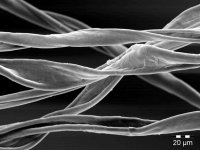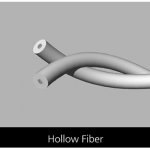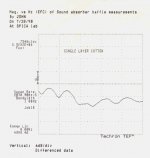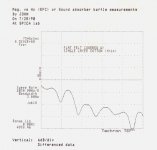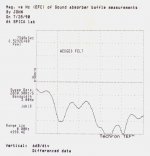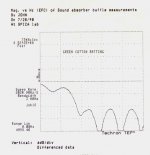Cool, thanks guys. BTW, I have a bunch of it so if anyone's in the Atlanta area and wants some, send me a PM.
You would think the manufacturer would try to keep that stuff from being overly prone to moisture induced mold.or rot by some sort of treatment. If it goes into exterior walls it should be ok for a dryer area like a speaker enclosure.
Urethane foam is another option. It does well dampening enclosures. The downside to it is the tendency to break down faster and be a fire hazard. Not a good thing with hot components of crossovers mounted close by. A friend of mine built himself a bass guitar speaker that was dampened with PU foam and the Lpad for the tweeter got too hot, settting the foam on fire while he was playing a gig. The whole cab was a complete loss, including the drivers.
Yes, that is OK. If is required for vented enclosures, use it only for lining the inside walls of the cabinet. For closed box, fill about 50% of box volume fith that material.Here is what it looks like:
A couple of comments about Ultratouch. The stuff is becoming more difficult to find. The two big box stores no longer carry it. Also, does it need to be "teased" or gently pulled apart to change the density to be more "fluffy"?
Depends on how you use it. We mostly use the roll and i likely have enuff for life. The insulation can be used as is — we did that in microTower, but for most it would need teasing and that not so easy.
I gave away most of my insulation, i have alot of acoustastuff for where i would use it.
There ar eother brands doing similar things. But still not all that common.
dave
I gave away most of my insulation, i have alot of acoustastuff for where i would use it.
There ar eother brands doing similar things. But still not all that common.
dave
DuPont Sorona is a brand of hollow polyester fiber used for stuffing pillows and mattresses.
It is also made by many other competitors, I put the name as an example.
I would like to know if it has been used for speakers...
It is also made by many other competitors, I put the name as an example.
I would like to know if it has been used for speakers...
Hollow polyester fibre will certainly provide superior heat insulation because of the air trapped in the centre of the fibres - good for filling duvets etc.
Cotton fibres have randomly distributed diameters, while hollow polyester fibres all have the same diameter (see attachments).
It is this randomness in diameter that makes cotton the better absorber of sound energy.
Cotton fibres have randomly distributed diameters, while hollow polyester fibres all have the same diameter (see attachments).
It is this randomness in diameter that makes cotton the better absorber of sound energy.
Attachments
What about its acoustic properties, particularly in speakers used in tropical climates?
Hollow fiber, I mean...
And maybe it can be made a little random, by tossing it around, or in pillow type bags made with open weave fabric?
Hollow fiber, I mean...
And maybe it can be made a little random, by tossing it around, or in pillow type bags made with open weave fabric?
I read that hollow polyester fibres have been widely used in sound absorption and noise reduction.
"Nonwoven (hollow fibre) fabrics have unique advantage to reduce medium frequency (1000–2000 Hz) and high frequency (over 2000 Hz) noise."
I suspect that hollow fibre provides extra sound energy absorption through the mechanism of the sound pressure wave alternately compressing and rarifying the air trapped within the fibre - similar to the way closed cell acoustic foam works to absorb sound.
"Nonwoven (hollow fibre) fabrics have unique advantage to reduce medium frequency (1000–2000 Hz) and high frequency (over 2000 Hz) noise."
I suspect that hollow fibre provides extra sound energy absorption through the mechanism of the sound pressure wave alternately compressing and rarifying the air trapped within the fibre - similar to the way closed cell acoustic foam works to absorb sound.
How does this behavior differ from cotton and other materials in acoustic usage, do the parameters require crossover modification for different types of fill / lining of the speakers?
As in slopes, frequencies?
Does this mean I would need to do that from say, woollen felt to hollow fiber?
As in slopes, frequencies?
Does this mean I would need to do that from say, woollen felt to hollow fiber?
I've used a lotof different fill, lining and the like.
Ultratouch, Bonded Logic recycled denim stuff is really nice. The packing shown above works quite well too.
I have used cotton balls, just sprayed adhesive, and poured them into the box and hand packed them. That was a messy process, but worked well.
Rockwool/SafeNSound takes up volume but really sucks the life out of the resonances. It's very effective by yell test.
Wool batting like the Monacor Dammwolle, or craft store variety really works well, and I prefer it to Dacron.
Shredded Bamboo NaturFil fill was very impressive, but it seems it's NLA. I still have quite a bit left.
Acoustistuf is better than polyfil, and the 'premium' fill from Morning Glory, Polyfil, etc, is better than the non premium polyfil stuff. The white stuff, not the gray.
Ultratouch, Bonded Logic recycled denim stuff is really nice. The packing shown above works quite well too.
I have used cotton balls, just sprayed adhesive, and poured them into the box and hand packed them. That was a messy process, but worked well.
Rockwool/SafeNSound takes up volume but really sucks the life out of the resonances. It's very effective by yell test.
Wool batting like the Monacor Dammwolle, or craft store variety really works well, and I prefer it to Dacron.
Shredded Bamboo NaturFil fill was very impressive, but it seems it's NLA. I still have quite a bit left.
Acoustistuf is better than polyfil, and the 'premium' fill from Morning Glory, Polyfil, etc, is better than the non premium polyfil stuff. The white stuff, not the gray.
How does this behavior differ from cotton and other materials in acoustic usage, do the parameters require crossover modification for different types of fill / lining of the speakers?
Hollow polyster fibre appears to absorb energy selectively over a limited range of frequencies (as indicated in my quote above).
Cotton will absorb energy selectively over a different range of frequencies and may be more effective at lower frequencies.
Just for interest, I'll point to the study of the sound absorption properties of nonwoven fabrics that is undertaken in this paper:
https://www.researchgate.net/figure...er-nonwoven-composites-and-the_fig3_258196643
The conclusions of this particular study were:
"Low-frequency sound absorption is directly related with the thickness of the material whereas high frequency absorption properties are not significantly affected beyond a saturation value of the thickness of the material. The increase in the number of fibers per unit area results in an increase in the apparent density of the material. As the density of the sample increases, sound absorption value tends to increase in the mid- to-high frequency ranges."
To answer the second part of your question, I've never read of crossover modification being necessary when transitioning from one absorbent material to another.
The conclusions of this particular study were:
"Low-frequency sound absorption is directly related with the thickness of the material whereas high frequency absorption properties are not significantly affected beyond a saturation value of the thickness of the material."
I found the measurements I made years ago. Unfortunately they're all on separate graphs, and I didn't save the individual sweeps 🙁. But they agree with the above statement completely, though I would say "thickness, geometry, and density" (the latter, to a point).
Dacron or Hollofill never seems to do a good job in the mid frequencies on down for me. It does very little in the low mids, even using larger amounts, making it a poor choice in stuffed sealed cabs.
Wool just is the most neutral material IMO. It doesn't ruin the lower mids compared to fiberglass or rockwool, which just kills the detail in the bass and mids.
I have little experience with the cotton stuff. It may be better than Rockwool or fiberglass. I've had decent luck with some brands of carpet underlayment but I'm sure there are big differences among brands of it. Probably better to use modern versions of urethane foam if you're careful with it.
Wool just is the most neutral material IMO. It doesn't ruin the lower mids compared to fiberglass or rockwool, which just kills the detail in the bass and mids.
I have little experience with the cotton stuff. It may be better than Rockwool or fiberglass. I've had decent luck with some brands of carpet underlayment but I'm sure there are big differences among brands of it. Probably better to use modern versions of urethane foam if you're careful with it.
Ignore the bit abou Bradbury’s equation, it has been shown to be wrong, but at the bottom are a bunch of charts that might help understand damping: https://www.t-linespeakers.org/projects/tlB/appendix/bradbury/index.html
dave
dave
Here's a handful of the measurements I mentioned above. The measurement's setup:
: speaker and mic placed next to each other, pointing at a wall-mounted 4'x8' sheet of MDF about 8.5' away.
: Analyzer time offset adjusted to capture the reflection off the board.
: Reference sweep (linear sweep 0-5kHz) of the reflected spectrum made and saved
: For each measurement, the board is covered with the material being tested
: Difference data (material spectrum minus reference spectrum) is plotted
The materials are
1: Low-density wool felt 3/4" thick (80% wool minimum)
2. 1 layer of cotton batting, roughly 2" thick, similar to the OP's material.
3. The wool felt covered with the cotton batting.
4. The wool felt (7" squares) folded into 3" thick "acoustic wedges"
5. Medium-dense cotton batting pressed into sheets approx. 1.25" thick
#5 is material similar to the stuff that was used as hood and panel damping material in autos.
: speaker and mic placed next to each other, pointing at a wall-mounted 4'x8' sheet of MDF about 8.5' away.
: Analyzer time offset adjusted to capture the reflection off the board.
: Reference sweep (linear sweep 0-5kHz) of the reflected spectrum made and saved
: For each measurement, the board is covered with the material being tested
: Difference data (material spectrum minus reference spectrum) is plotted
The materials are
1: Low-density wool felt 3/4" thick (80% wool minimum)
2. 1 layer of cotton batting, roughly 2" thick, similar to the OP's material.
3. The wool felt covered with the cotton batting.
4. The wool felt (7" squares) folded into 3" thick "acoustic wedges"
5. Medium-dense cotton batting pressed into sheets approx. 1.25" thick
#5 is material similar to the stuff that was used as hood and panel damping material in autos.
Attachments
It's interesting to compare those reflection notches.
I would appreciate a brief summary of your conclusions, jbau.
I would appreciate a brief summary of your conclusions, jbau.
Here's a handful of the measurements
TDS… love it, i supposedly own a B&K TDS tool. Need to get to Calgary and pick it up.
dave
- Home
- Design & Build
- Parts
- Useful for speaker cabinet fill?
